Comparative Study of Tribological and Corrosion Characteristics of TiCN, TiCrCN, and TiZrCN Coatings
Abstract
:1. Introduction
2. Materials and Methods
2.1. Substrate Preparation and Coating Process
2.2. Morphology and Composition of Coatings
2.3. Tribological Tests
2.4. Nanohardness
2.5. Corrosion Testing
3. Results and Discussion
3.1. Morphology and Composition of Coatings
3.2. Tribological Testing of Coatings
3.3. Nanohardness of Coatings
3.4. Corrosion Testing of Coatings
4. Conclusions
Author Contributions
Funding
Institutional Review Board Statement
Informed Consent Statement
Data Availability Statement
Conflicts of Interest
References
- Srinath, M.K.; Ganesha, M.S.P. Wear and corrosion resistance of titanium carbo-nitride coated Al-7075 produced through PVD. Bull. Mater. Sci. 2020, 43, 108. [Google Scholar] [CrossRef]
- Li, Z.; Di, S. The microstructure and wear resistance of microarc oxidation composite coatings containing nano-hexagonal boron nitride (HBN) particles. J. Mater. Eng. Perform. 2017, 26, 1551–1561. [Google Scholar] [CrossRef]
- Ramazanova, J.M.; Zamalitdinova, M.G. Physical and mechanical properties investigation of oxide coatings on titanium. Complex Use Miner. Resour. 2019, 2, 34–41. [Google Scholar] [CrossRef]
- Almagul, U.; Bagdaulet, K.; Murat, O.; Azamat, Y.; Kaysar, K. Investigations of waste sludge of titanium production and its leaching by nitric acid. In Proceedings of the International Multidisciplinary Scientific Geoconference Surveying Geology and Mining Ecology Management SGEM, Albena, Bulgaria, 28 June 2019. [Google Scholar]
- Yeshmanova, G.B.; Smagulov, D.U.; Blawert, C. Plasma electrolytic oxidation technology for producing protective coatings of aluminum alloys. Complex Use Miner. Resour. 2021, 2, 78–93. [Google Scholar] [CrossRef]
- Kopf, A.; Haubner, R.; Lux, B. Double-layer coatings on WC-Co hardmetals containing diamond and titanium carbide/nitride. Diam. Relat. Mater. 2000, 9, 494–501. [Google Scholar] [CrossRef]
- Matei, A.A.; Pencea, I.; Branzei, M.; Tranca, D.E.; Ţepeş, G.; Ţepeş, C.E.; Ciovica (Coman), E.; Gherghilescu, A.I.; Stanciu, G.A. Corrosion resistance appraisal of TiN, TiCN and TiAlN coatings deposited by CAE-PVD method on WC–Co cutting tools exposed to artificial sea water. Appl. Surf. Sci. 2015, 358, 572–578. [Google Scholar] [CrossRef]
- Su, J.F.; Yu, D.; Nie, X.; Hu, H. Inclined impact-sliding wear tests of TiN/Al2O3/TiCN coatings on cemented carbide substrates. Surf. Coat. Technol. 2011, 206, 1998–2004. [Google Scholar] [CrossRef]
- Gil, L.E.; Liscano, S.; Goudeau, P.; Le Bourhis, E.; Puchi-Cabrera, E.S.; Staia, M.H. Effect of TiAlN PVD coatings on corrosion performance of WC–6%Co. Surf. Eng. 2010, 26, 562–566. [Google Scholar] [CrossRef]
- Rakhadilov, B.; Buitkenov, D.; Idrisheva, Z.; Zhamanbayeva, M.; Pazylbek, S.; Baizhan, D. Effect of Pulsed-Plasma Treatment on the Structural-Phase Composition and Tribological Properties of Detonation Coatings Based on Ti–Si–C. Coatings 2021, 11, 795. [Google Scholar] [CrossRef]
- Gassner, M.; Schalk, N.; Tkadletz, M.; Pohler, M.; Czettl, C.; Mitterer, C. Influence of cutting speed and workpiece material on the wear mechanisms of CVD TiCN/A-Al2O3 coated cutting inserts during turning. Wear 2018, 398, 90–98. [Google Scholar] [CrossRef]
- Braic, V.; Braic, M.; Balaceanu, M.; Vladescu, A.; Zoita, C.N.; Titorencu, I.; Jing, V. (Zr,Ti)CN coatings as potential candidates for biomedical applications. Surf. Coat. Technol. 2011, 206, 604–609. [Google Scholar] [CrossRef]
- Zhang, D.; Shen, B.; Sun, F. Study on tribological behavior and cutting performance of CVD diamond and DLC films on Co-cemented tungsten carbide substrates. Appl. Surf. Sci. 2010, 256, 2479–2489. [Google Scholar] [CrossRef]
- Mansurov, B.; Medyanova, B.; Kenzhegulov, A.; Partizan, G.; Zhumadilov, B.; Mansurova, M.; Koztayeva, U.; Lesbayev, B. Investigation of microdiamonds obtained by the oxygen-acetylene torch method. Eurasian Chem.-Technol. J. 2017, 19, 163–167. [Google Scholar] [CrossRef] [Green Version]
- Razmi, A.; Yesildal, R. Microstructure and mechanical properties of TiN/TiCN/TiC multilayer thin films deposited by magnetron sputtering. Int. J. Innov. Res. Rev. 2021, 5, 15–20. [Google Scholar] [CrossRef]
- Chen, R.; Tu, J.P.; Liu, D.G.; Mai, Y.J.; Gu, C.D. Microstructure, mechanical and tribological properties of TiCN nanocomposite films deposited by DC magnetron sputtering. Surf. Coat. Technol. 2011, 205, 5228–5234. [Google Scholar] [CrossRef]
- Matei, A.A.; Pencea, I.; Stanciu, S.G.; Hristu, R.; Antoniac, I.; Ciovica (Coman), E.; Sfat, C.E.; Stanciu, G.A. Structural characterization and adhesion appraisal of TiN and TiCN coatings deposited by CAE-PVD technique on a new carbide composite cutting tool. J. Adhes. Sci. Technol. 2015, 29, 2576–2589. [Google Scholar] [CrossRef]
- Zhu, L.; He, J.; Yan, D.; Liao, H.; Zhang, N. Oxidation behavior of titanium carbonitride coating deposited by atmospheric plasma spray synthesis. J. Therm. Spray Technol. 2017, 26, 1701–1707. [Google Scholar] [CrossRef]
- Yang, Y.; Guo, N.; Li, J. Synthesizing, microstructure and microhardness distribution of Ti−Si−C−N/TiCN composite coating on Ti−6Al−4V by laser cladding. Surf. Coat. Technol. 2013, 219, 1–7. [Google Scholar] [CrossRef]
- Zhang, J.; Xue, Q.; Li, S. Microstructure and corrosion behavior of TiC/Ti(CN)/TiN multilayer CVD coatings on high strength steels. Appl. Surf. Sci. 2013, 280, 626–631. [Google Scholar] [CrossRef]
- Stanishevsky, A.; Lappalainen, R. Tribological properties of composite Ti(N,O,C) coatings containing hard amorphous carbon layers. Surf. Coat. Technol. 2000, 123, 101–105. [Google Scholar] [CrossRef]
- Olteanu, C.; Munteanu, D.; Ionescu, C.; Munteanu, A. Tribological characterisation of magnetron sputtered Ti(C, O, N) thin films. Int. J. Mater. Prod. Technol. 2010, 39, 186–194. [Google Scholar] [CrossRef] [Green Version]
- Hsieh, J.H.; Wu, W.; Li, C.; Yu, C.H.; Tan, B.H. Deposition and characterization of Ti(C,N,O) coatings by unbalanced magnetron sputtering. Surf. Coat. Technol. 2003, 163, 233–237. [Google Scholar] [CrossRef]
- Zhou, R.; Ju, H.; Liu, S.; Zhao, Z.; Xu, J.; Yu, L.; Qian, H.; Jia, S.; Song, R.; Shen, J. The influences of Ag content on the friction and wear properties of TiCN–Ag films. Vacuum 2022, 196, 110719. [Google Scholar] [CrossRef]
- Sanchez-Lopez, J.C.; Abad, M.D.; Carvalho, I.; Escobar, G.R.; Benito, N.; Ribeiro, S.; Henriques, M.; Cavaleiro, A.; Carvalho, S. Influence of silver content on the tribomechanical behavior on Ag-TiCN bioactive coatings. Surf. Coat. Technol. 2012, 206, 2192–2198. [Google Scholar] [CrossRef] [Green Version]
- Hatem, A.; Lin, J.; Wei, R.; Torres, R.D.; Laurindo, C.; Biscaia de Souza, G.; Soares, P. Tribocorrosion behavior of low friction TiSiCN nanocomposite coatings deposited on titanium alloy for biomedical applications. Surf. Coat. Technol. 2018, 347, 1–12. [Google Scholar] [CrossRef]
- Zhang, S.; Fu, Y.; Du, H.; Zeng, X.T.; Liu, Y.C. Magnetron sputtering of nanocomposite (Ti,Cr)CNyDLC coatings. Surf. Coat. Technol. 2002, 162, 42–48. [Google Scholar] [CrossRef]
- Pruncu, C.I.; Braic, M.; Dearn, K.D.; Farcau, C.; Watson, R.; Constantin, L.R.; Balaceanu, M.; Braic, V.; Vladescu, A. Corrosion and tribological performance of quasi-stoichiometric titanium containing carbo-nitride coatings. Arab. J. Chem. 2016, 10, 1015–1028. [Google Scholar] [CrossRef]
- Braic, M.; Balaceanu, M.; Vladescu, A.; Zoita, C.N.; Braic, V. Study of (Zr,Ti)CN, (Zr,Hf)CN and (Zr,Nb)CN films prepared by reactive magnetron sputtering. Thin Solid Films 2011, 519, 4092–4096. [Google Scholar] [CrossRef]
- GOST 19807-91 Wrought Titanium and Titanium Alloys. Grades GOST № 19807-91 from 17 July 1991. Available online: http://vsegost.com/Catalog/28/28149.shtml (accessed on 30 March 2022).
- Mamaeva, A.; Kenzhegulov, A.; Panichkin, A.; Alibekov, Z.; Wieleba, W. Effect of Magnetron Sputtering Deposition Conditions on the Mechanical and Tribological Properties of Wear-Resistant Titanium Carbonitride Coatings. Coatings 2022, 12, 193. [Google Scholar] [CrossRef]
- Stueber, M.; Barna, P.B.; Simmonds, M.C.; Albers, U.; Leiste, H.; Ziebert, C.; Holleck, H.; Kovács, A.; Hovsepian, P.; Gee, I. Constitution and microstructure of magnetron sputtered nanocomposite coatings in the system Ti–Al–N–C. Thin Solid Films 2005, 493, 104–112. [Google Scholar] [CrossRef]
- Gall, D.; Kodambaka, S.; Wall, M.A.; Petrov, I.; Greene, J.E. Pathways of atomistic processes on TiN(001) and (111) surfaces during film growth: An ab initio study J. Appl. Phys. 2003, 93, 9086–9094. [Google Scholar] [CrossRef] [Green Version]
- Cahn, R.W.; Haasen, P. Physical metallurgy. Phys. Metall. 1996, 1, 1042–1048. [Google Scholar]
- Mechri, H.; Saoula, N.; Madaoui, N. Friction and wear behaviors of TiCN coating treated by R.F magnetron sputtering. In Proceedings of the 7th African Conference on Non Destructive Testing ACNDT 2016 & the 5th International Conference on NDT and Materials Industry and Alloys (IC-WNDT-MI): Research Center in Industrial Technologies CRTI, Algiers, Algeria, 31 July 2016. [Google Scholar]
- Kenzhegulov, A.K.; Mamayeva, A.A.; Panichkin, A.V. Adhesion properties of calcium phosphate coatings on titanium. Complex Use Miner. Resour. 2017, 3, 35–41. [Google Scholar]
- Siow, P.C.; Ghani, J.A.; Ghazali, M.J.; Jaafar, T.R.; Selamat, M.A.; Haron, C.H.C. Characterization of TiCN and TiCN/ZrN coatings for cutting tool application. Ceram. Int. 2013, 39, 1293–1298. [Google Scholar] [CrossRef]
- Musil, J.; Jirout, M. Toughness of hard nanostructured ceramic thin films. Surf. Coat. Technol. 2007, 201, 5148–5152. [Google Scholar] [CrossRef]
- Hall, E.O. The Deformation and Ageing of Mild Steel: III Discussion of Results. Proc. Phys. Soc. B 1951, 64, 747–753. [Google Scholar] [CrossRef]
- Petch, N.J. The Cleavage Strength of Polycrystals. J. Iron Steel Inst. 1953, 174, 25–28. [Google Scholar]
- Holleck, H. Designing advanced coatings for wear protection. Surf. Eng. 1991, 7, 137–144. [Google Scholar] [CrossRef]
- Jang, C.S.; Jeon, J.-H.; Song, P.K.; Kang, M.C.; Kim, K.H. Synthesis and mechanical properties of TiAlCxN1−x coatings deposited by arc ion plating. Surf. Coat. Technol. 2005, 200, 1501–1506. [Google Scholar] [CrossRef]
- Leyland, A.; Matthews, A. On the significance of the H/E ratio in wear control: A nanocomposite coating approach to optimized tribological behavior. Wear 2000, 246, 1–11. [Google Scholar] [CrossRef]
- Lou, J.; Gao, Z.; Zhang, J.; He, H.; Wang, X. Comparative investigation on corrosion resistance of stainless steels coated with titanium nitride, nitrogen titanium carbide and titanium-diamond-like carbon films. Coatings 2021, 11, 1543. [Google Scholar] [CrossRef]
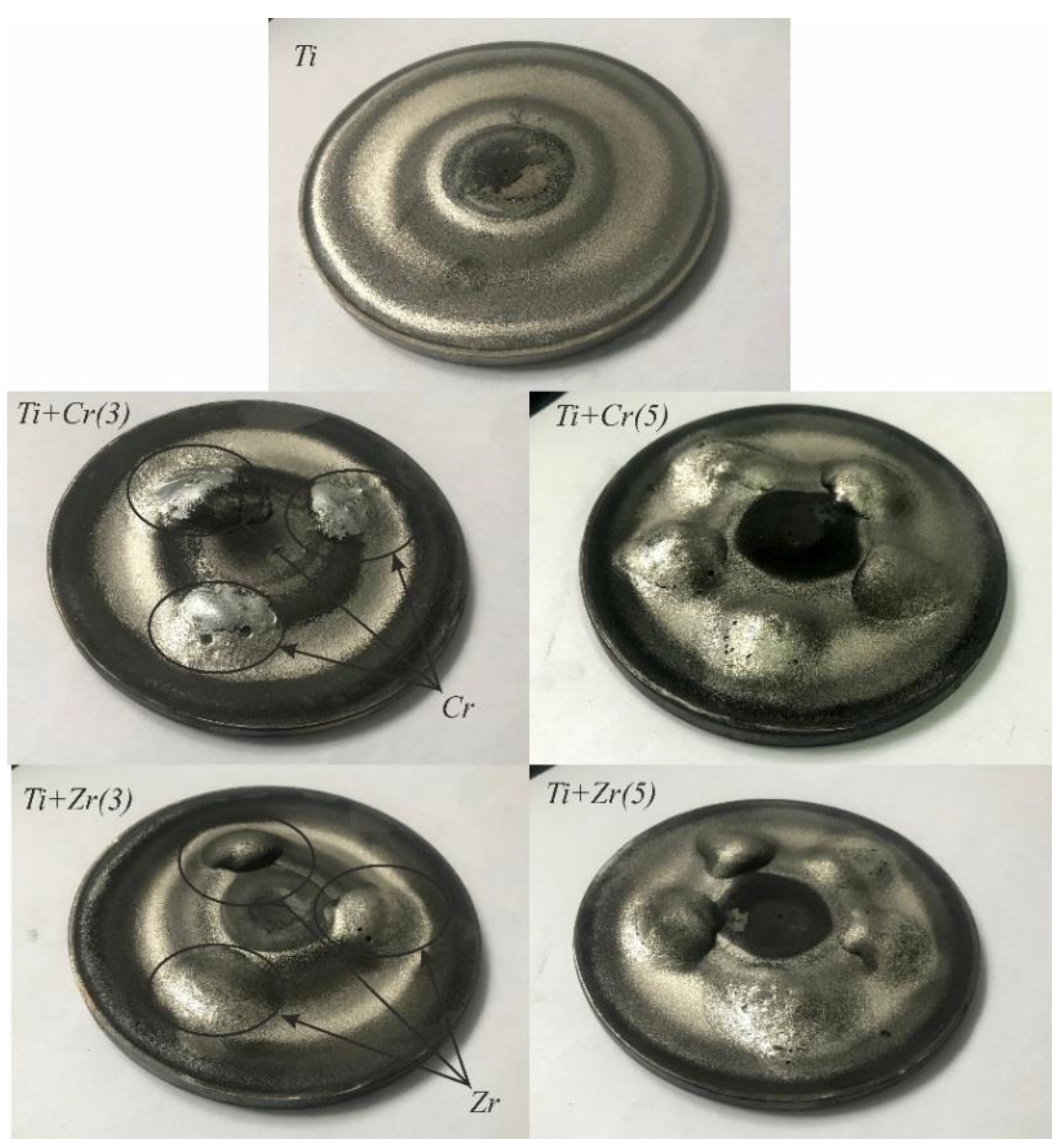

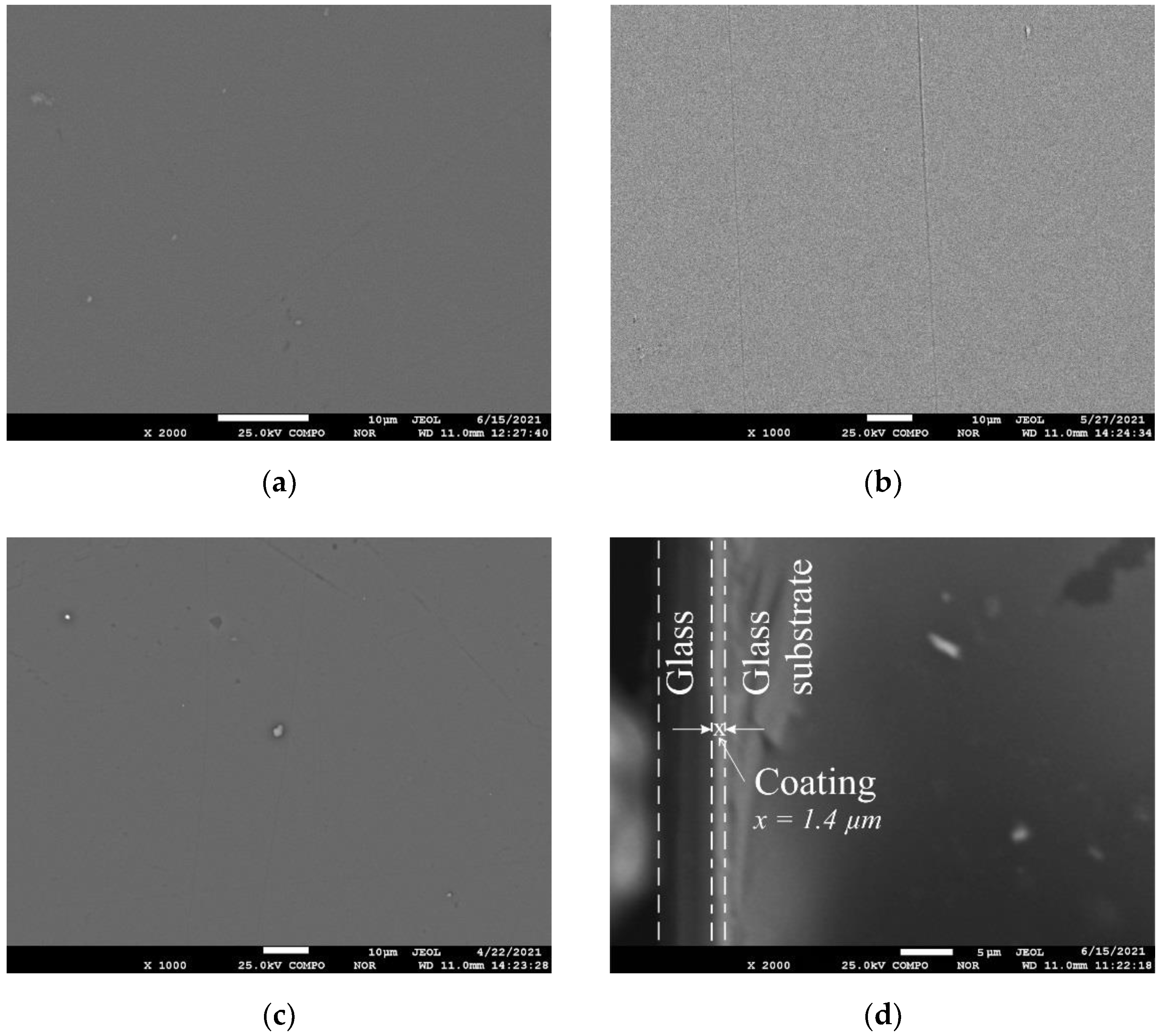
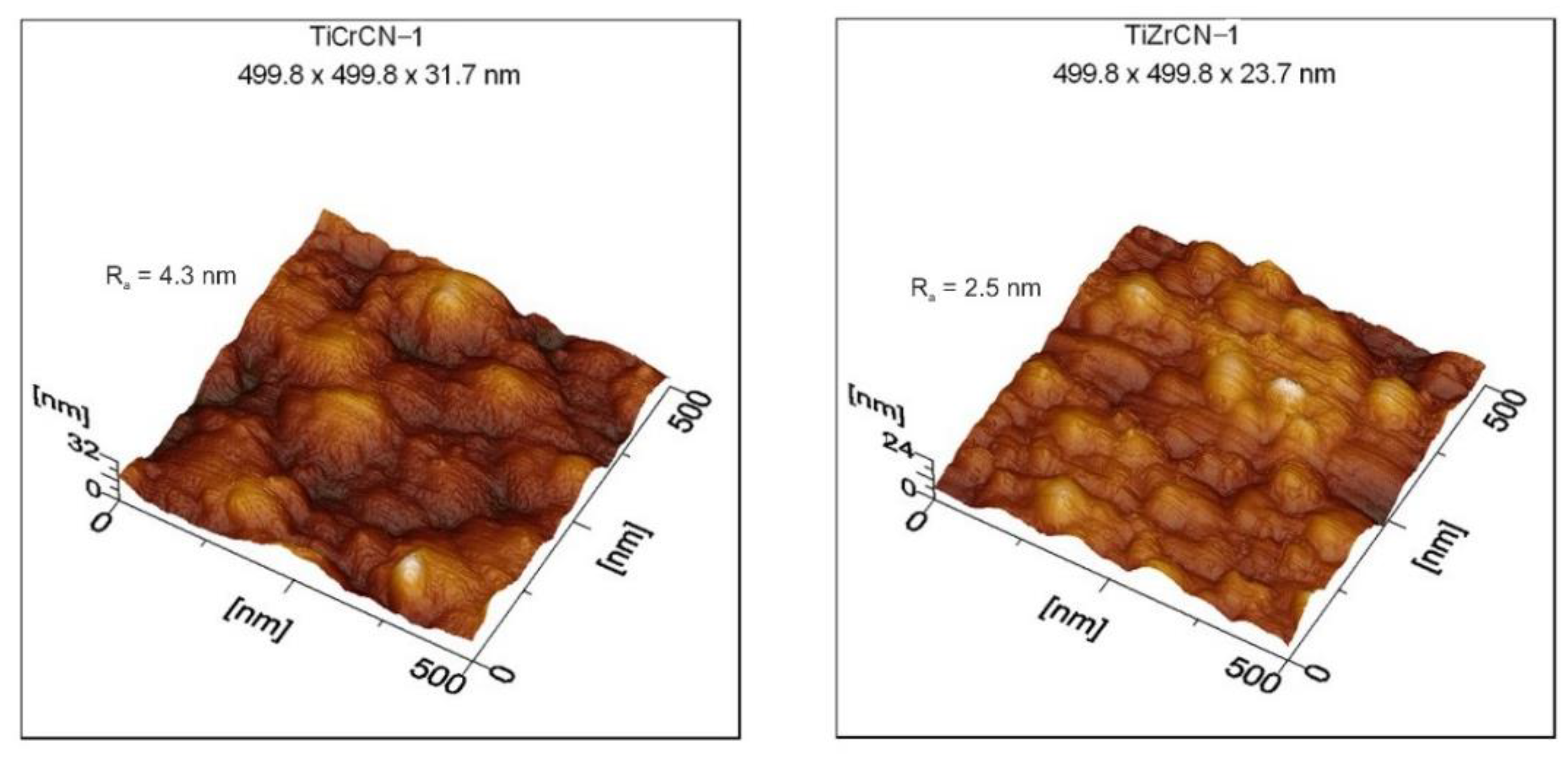

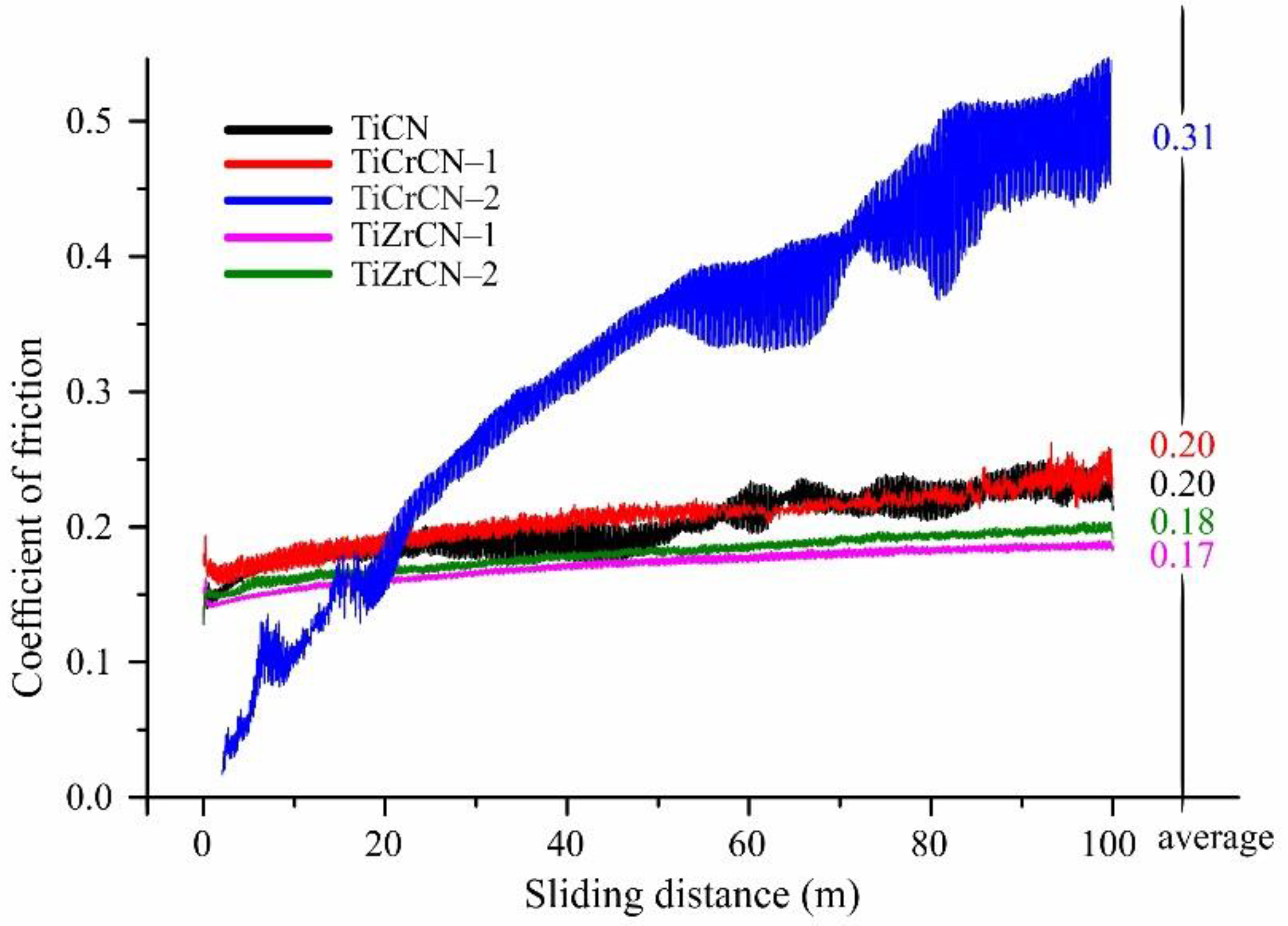
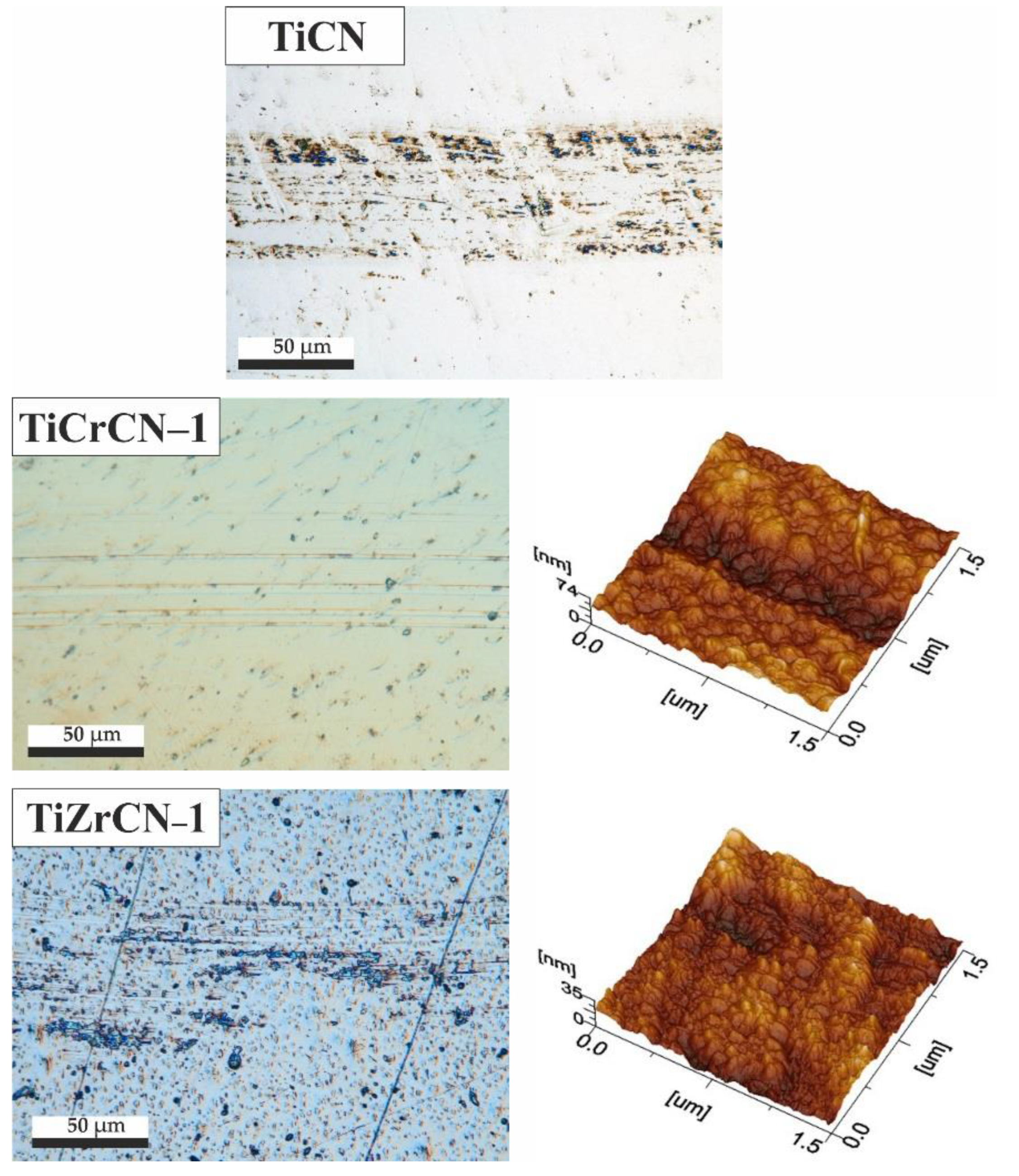

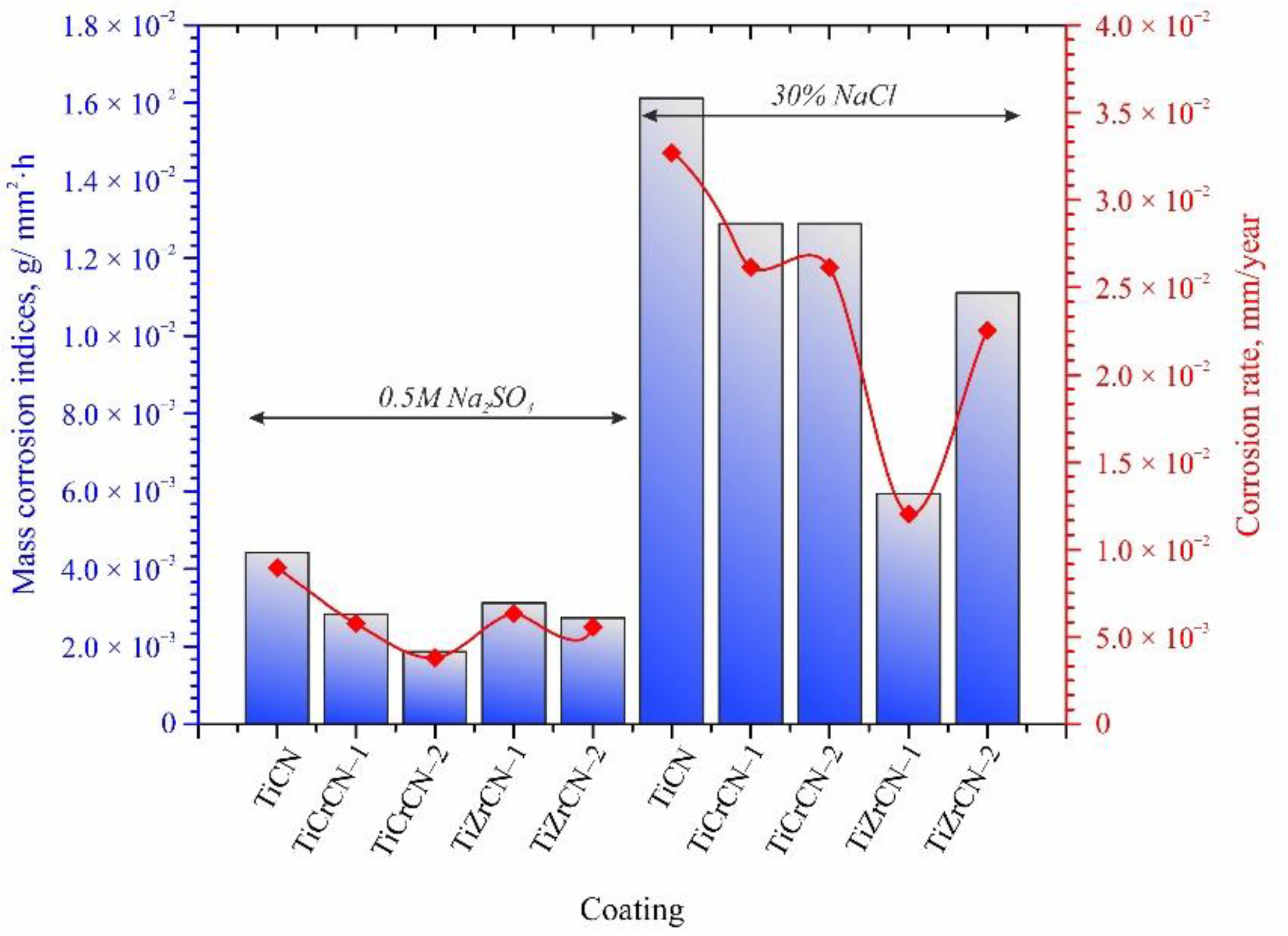
| Titanium Brand | The Content of Elements, No More, wt.% | |||||||
|---|---|---|---|---|---|---|---|---|
| Ti | Fe | Si | C | O | N | H | Other | |
| VT1–0 | 99.24–99.7 | up to 0.20 | up to 0.1 | up to 0.07 | up to 0.2 | up to 0.04 | up to 0.01 | up to 0.10 |
| Coating | Coating Deposition Parameters | ||||
|---|---|---|---|---|---|
| Target Type | Chamber Pressure, Pa | Flow of Inert and Reactive Gas, sccm | Plasma Current, A | Sputtering Time, min | |
| TiCN | Ti | 0.45 | Ar = 18; C2H2 = 3.6; N2 = 3 | 2 | 120 |
| TiCrCN-1 TiCrCN-2 | Ti+Cr(3) Ti+Cr(5) | 0.45 | Ar = 18; C2H2 = 4.6; N2 = 3 | 2 | 120 |
| TiZrCN-1 TiZrCN-2 | Ti+Zr(3) Ti+Zr(5) | 0.45 | Ar =1 8; C2H2 = 4.6; N2 = 3 | 2 | 120 |
| Coating | Coating Characteristics | ||
|---|---|---|---|
| Thickness, μm | Deposition Rate, nm/min | Roughness Ra, nm | |
| TiCN | 1.40 | 11.60 | 9.78 |
| TiCrCN-1 | 1.55 | 12.91 | 4.30 |
| TiCrCN-2 | 1.60 | 13.40 | 7.28 |
| TiZrCN-1 | 1.74 | 14.50 | 2.50 |
| TiZrCN-2 | 1.81 | 15.13 | 5.14 |
| Coating | Elemental Composition of Deposited Coatings, at.% | (C + N)/(Sum of Metals) | ||||
|---|---|---|---|---|---|---|
| Ti | C | N | Cr | Zr | ||
| TiCN | 53.6 | 16.0 | 30.4 | – | – | 0.87 |
| TiCrCN-1 | 34.1 | 28.7 | 19.7 | 17.5 | – | 0.94 |
| TiCrCN-2 | 14.2 | 26.5 | 22.6 | 36.7 | – | 0.96 |
| TiZrCN-1 | 20.8 | 34.7 | 32.4 | – | 12.1 | 2.04 |
| TiZrCN-2 | 22.3 | 17.8 | 43.8 | – | 16.1 | 1.61 |
| Coating | Average CoF | Wear Track Width (mm) | Wear Loss Volume (mm3) | Coating Wear Rate mm3/(m∙N) |
|---|---|---|---|---|
| TiCN | 0.20 | 0.21 ± 0.16 × 10–2 | 4.81 ± 2.33 × 10–3 | 1.9 ± 0.58 × 10–5 |
| TiCrCN-1 | 0.20 | 0.19 ± 0.17 × 10–2 | 13.15 ± 0.6 × 10–5 | 8.4 ± 1.22 × 10–7 |
| TiCrCN-2 | 0.31 | 0.45 ± 0.2 × 10–2 | 2.48 ± 1.1 × 10–3 | 4.14 ± 1.83 × 10–5 |
| TiZrCN-1 | 0.17 | 0.15 ± 0.12 × 10–2 | 3.3 ± 1.53 × 10–5 | 3.35 ± 0.42 × 10–7 |
| TiZrCN-2 | 0.18 | 0.33 ± 0.02 × 10–2 | 11.3 ± 2.3 × 10–4 | 5.4 ± 3.9 × 10–6 |
Publisher’s Note: MDPI stays neutral with regard to jurisdictional claims in published maps and institutional affiliations. |
© 2022 by the authors. Licensee MDPI, Basel, Switzerland. This article is an open access article distributed under the terms and conditions of the Creative Commons Attribution (CC BY) license (https://creativecommons.org/licenses/by/4.0/).
Share and Cite
Kenzhegulov, A.; Mamaeva, A.; Panichkin, A.; Alibekov, Z.; Kshibekova, B.; Bakhytuly, N.; Wieleba, W. Comparative Study of Tribological and Corrosion Characteristics of TiCN, TiCrCN, and TiZrCN Coatings. Coatings 2022, 12, 564. https://doi.org/10.3390/coatings12050564
Kenzhegulov A, Mamaeva A, Panichkin A, Alibekov Z, Kshibekova B, Bakhytuly N, Wieleba W. Comparative Study of Tribological and Corrosion Characteristics of TiCN, TiCrCN, and TiZrCN Coatings. Coatings. 2022; 12(5):564. https://doi.org/10.3390/coatings12050564
Chicago/Turabian StyleKenzhegulov, Aidar, Axaule Mamaeva, Aleksandr Panichkin, Zhasulan Alibekov, Balzhan Kshibekova, Nauryzbek Bakhytuly, and Wojciech Wieleba. 2022. "Comparative Study of Tribological and Corrosion Characteristics of TiCN, TiCrCN, and TiZrCN Coatings" Coatings 12, no. 5: 564. https://doi.org/10.3390/coatings12050564
APA StyleKenzhegulov, A., Mamaeva, A., Panichkin, A., Alibekov, Z., Kshibekova, B., Bakhytuly, N., & Wieleba, W. (2022). Comparative Study of Tribological and Corrosion Characteristics of TiCN, TiCrCN, and TiZrCN Coatings. Coatings, 12(5), 564. https://doi.org/10.3390/coatings12050564








